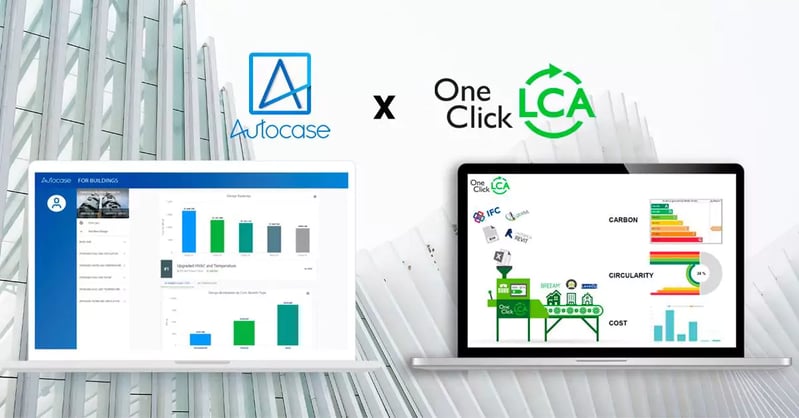
New integration of Life Cycle Analysis and Triple Bottom Line tools tells whole carbon story. Embodied carbon emissions from the materials used in buildings can now be combined with the operational carbon from energy and water saving initiatives. For the first time embodied and operational carbon can be evaluated at the early planning or conceptual design stage using One Click LCA and Autocase.
Helsinki, Finland / New York, U.S. – A timely integration of One Click LCA and Autocase allows building owners, architects, and policy designers to plan and design for the embodied and operational carbon emissions in buildings and to work towards net zero carbon.
It is well known that the carbon emissions from building operation are a significant challenge. However, tackling those is no longer enough to meet climate goals. Embodied carbon, that is the emissions from the extraction, processing, transport, and disposal of materials, is widely recognized as the next challenge to stay within our carbon budget. The embodied carbon in building materials is expected to be as large as the operational carbon from global new building construction until 2050. The challenge has been that bringing embodied and operational carbon together to evaluate trade-offs and set priorities, has only been available in the detailed design stage, when a lifecycle analysis (LCA) is done as materials are selected.
A partnership between One Click LCA and Autocase changes the landscape and allows embodied and operational carbon analysis at an early stage, when the costs of changes are small and the opportunities for carbon savings are large. One Click LCA is a life cycle metrics software that allows the embodied carbon in building materials to be estimated knowing only the location, size, and type of building. Users can create baseline buildings or concept phase options instantly and calculate an early-stage LCA. The results can be then refined as design progresses, up to selecting specific products and suppliers to reduce project carbon impacts.
Autocase is software that calculates the social, financial and environmental (triple bottom line, TBL) impacts of designs as they relate to energy, water, material choices and more. Both cloud-based software tools allow for analyses based on minimal information – building location, size, shape, and type. The integrated TBL and LCA analyses use local information on energy grid, water scarcity, as well as wages and prices. It also includes climate change scenarios and allows users to override or update information as the design progresses.
To ensure clear, transparent and robust outcomes to guide further design, the Stage 2 Report uses detailed embodied carbon analysis through One Click LCA at component level, focusing on the most critical elements in order to evaluate the relevant opportunities for improvement during Stage 3. A full WLC Assessment will be undertaken at Stage 4 when there is sufficient resolution to provide robust global results for the development.
One Click LCA and Autocase software users can now import the building material embodied carbon from One Click LCA’s innovative early stage planning tool into Autocase. This allows users to see the carbon emissions saved from:
- The embodied carbon (extraction, processing, transport, and disposal) of material choices and lower carbon materials options
- The operational carbon from energy and water efficiency initiatives from features such as various HVAC options;
- The operational carbon from renewable energy production; and,
- The carbon sequestration in green roofs and other green infrastructure initiatives;
- The operational carbon from rainwater harvesting and greywater reuse.
“Building owners, architects and those regulating and setting policy in the buildings sector have only seen half of the carbon picture,” said John Williams, CEO and Chairman of Impact Infrastructure and Chairman of the Institute for Sustainable Infrastructure. “One Click LCA completes the view by giving them the embodied carbon picture. They can now make better decisions about our building assets and the environment”.
“We’re extremely pleased to deliver this integration with Autocase”, said Panu Pasanen, CEO of One Click LCA Ltd. “Autocase and One Click LCA have both been focused on providing information in the early planning or conceptual design stage. Together we can allow better decisions about the embodied and operational carbon footprint of buildings while those choices are still easy and cheap to make, and truly enable targeting net zero carbon”, he continued.
Visit http://www.autocaseoneclicklca.com/ for more information.

Contacts for media
For Impact Infrastructure (makers of Autocase):
John F. Williams II, Chief Executive Officer and Chairman,
+1 914 224 7639, john.williams@autocase.com
For One Click LCA:
Panu Pasanen, Chief Executive Officer,
+358 442871 722, panu.pasanen@oneclicklca.com
Impact Infrastructure Inc. (the makers of Autocase) Autocase is a software tool that models the environmental and social impacts of building designs and together with financial and lifecycle costs, evaluates their triple bottom line benefits using a rigorous cost-benefit analysis framework. For more information: www.autocase.com.
One Click LCA Ltd (formerly Bionova Ltd) is the developer of world-leading construction life-cycle assessment software One Click LCA. One Click LCA can be used in all stages of a project from early design to handover and commissioning. One Click LCA delivers WBLCA for LEED and net zero carbon design tools, among others. It integrates the world’s largest materials LCA and EPD database covering North America, Europe and Asia, and integrates with Autodesk Revit, IES-VE and many other building design software and data formats. For more information: www.oneclicklca.com.
Carbon Experts Newsletter
Industry news & insights — straight to your inbox
Want to learn more?
Asha Ramachandran • Sep 19 2023
Asha Ramachandran • Oct 08 2021
Laura Drury • Sep 24 2025
Kim Koivula • Apr 09 2025
